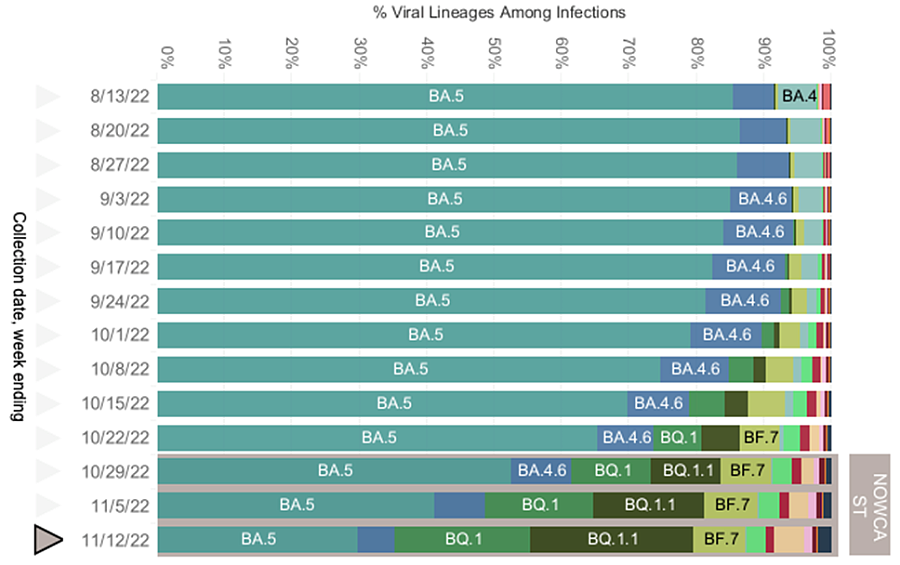Coronavirus Files: BQ variants on the rise, Moderna booster fights omicron

CDC

Have a suggestion or a request? Write us at editor@centerforhealthjournalism.org.
BQ variants unseat BA.5
A pair of variants likely to dominate the early winter months are emerging from the Scrabble soup. BQ.1, a descendant of omicron BA.5, and its own offshoot BQ.1.1 have been steadily increasing for weeks, and now collectively make up more than 49% of U.S. cases
“Preliminary data suggests they are better at evading immunity from COVID vaccines, including the new bivalent boosters, or a previous COVID infection than past versions of omicron,” writes Aria Bendix at NBC News. “That may give these subvariants higher transmissibility, which could fuel a rise in cases this winter.”
Early research, not yet peer reviewed, suggests the BQ pair of variants are better at invading human cells and escaping antibody defenses. Apoorva Mandavilli at The New York Times reports that BQ.1.1 is up to 175 times more resistant to immune defense than the original COVID strain, according to research by the team of Dr. Dan Barouch, director of the Center for Virology and Vaccine Research at Beth Israel Deaconess Medical Center.
“BQ.1.1 appears to be the most antibody-evasive variant that we’ve had to date,” Barouch told NBC.
This turnover of dominant variants could put Moderna’s and Pfizer’s latest bivalent vaccines, designed to target BA.5, behind the times. Moderna announced last week that its bivalent booster worked better than the original shots at creating antibodies against BA.5. Preliminary data with just 40 study subjects also suggests some protection against BQ.1.1, reports Matthew Herper at STAT.
“If you get the bivalent vaccine, you’ll increase your immunity to (BQ variants) by some extent,” virologist Andrew Pekosz of Johns Hopkins told NBC.
The good news: “Hospitalizations remain relatively stable,” notes The Washington Post. “This suggests the new mutated virus is not causing more serious illness — a welcome change.”
Disabled employment improving in pandemic’s wake
People with disabilities lost employment at about the same rate as others in the early days of the pandemic, but their employment rates have risen faster since the end of 2021, according to a November report by the National Bureau of Economic Research.
“The expansion in telework may have shifted the frontier of plausible employment opportunities for (people with disabilities),” write the authors, Ari Ne’eman and Nicole Maestas of Harvard University. “The economic recovery appears to have encouraged (people with disabilities) who had previously left (or never entered) the workforce to find employment.”
The researchers based their work on the Census Bureau’s Current Population Survey, and the findings match a recent report from the bipartisan Economic Innovation Group.
Companies that hire people with disabilities may not only find it easier to fill jobs, but also discover those employees excel at problem-solving due to ongoing experiences in their daily lives, writes Tanha Kaushal at Yahoo! Finance.
The Federal Reserve Bank of New York also notes that long COVID has created a new population of people with disabilities, which also contributes to the surge in employed people with disabilities.
Ne’eman and Maestras suggest that civil rights organizations, such as the U.S. Equal Employment Opportunity Commission, should monitor employers to ensure telework and other accommodations remain in place.
Public health experts losing jobs
As the nation enters its third COVID winter, amid an early and heavy-hitting flu season and hospitals overflowing with respiratory infection patients, thousands of public health workers are losing their jobs, reports Lauren Weber at Kaiser Health News.
During the pandemic, the nonprofit CDC Foundation was given nearly $289 million in COVID relief funding to hire about 4,000 nurses, epidemiologists, and communication specialists to support public health departments at the local and state level.
Now, the money is running out, and only about 800 of those employees are expected to keep their jobs.
“Even if funding were available to retain all 4,000 foundation employees, that would not have met public health staffing needs,” writes Weber. “The public health workforce in the U.S. has been underfunded for decades.”
One study suggests that 80,000 or more new employees would be necessary to meet the minimum needs of local and state public health departments.
Public health experts told Weber the chronic shortage leaves “the country unable to prevent and properly fight outbreaks.”
From the Center for Health Journalism
Apply today for our California Health Equity Impact Fund
This program offers mentorship, grants and support to reporters who think big and want to make a difference in their communities through investigative or explanatory reporting on promising approaches to chronic ills.
Signup Deadline: Friday, November 18. Learn more here!
What we’re reading
- “As the pandemic drags on, Americans struggle for new balance,” by Roni Caryn Rabin, The New York Times
- “Can we predict how well someone will respond to a vaccine?” by Natalia Mesa, The Scientist
- “Go ahead, joke about the pandemic,” by C. Brandon Ogbunu, The Atlantic
- “How the pandemic ended America’s bad romance with work,” by Helaine Olen, The Washington Post
Events & Resources
- Nov. 22, 4 p.m. PT: Science Writers in New York will discuss COVID, monkeypox and RSV in “A Virtual Conversation with New York Times Reporter Apoorva Mandavilli.”
- Nov. 29, 6–9 a.m. PT: The Scientist hosts a symposium on “COVID-19: Lessons Learned.”
- The CDC has a new kind of report, “COVID-19 Data Review,” to release COVID-19 information faster than the Morbidity and Mortality Weekly Reports. The first review covers the demographics of who’s dying from COVID-19 now.
- Listen to the podcast episode “Data Journalism in the Age of COVID-19” with Betsy Ladyzhets at Datacamp.

